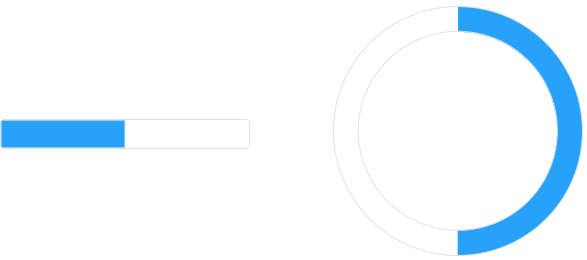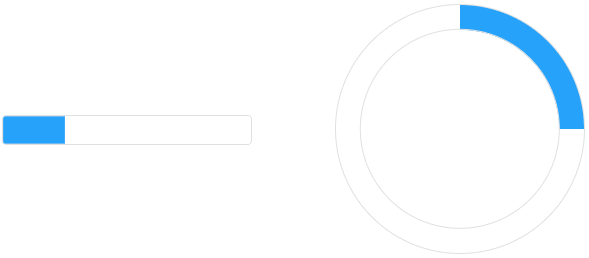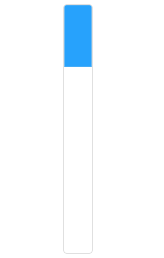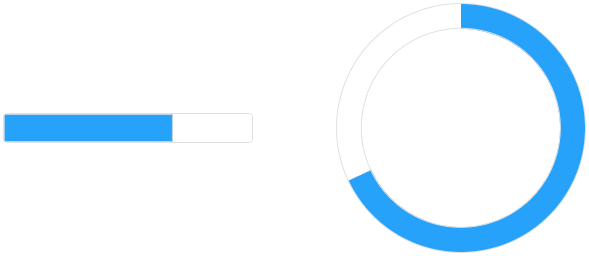Build your web apps using Smart UI
Smart.ProgressBar - configuration and usage.
Overview
Smart.ProgressBar represents a colored bar that displays the stage of the current process.
There are two types of Smart Progress bar element:
- Linear - smart-progress-bar
- Circular - smart-circular-progress-bar
Getting Started with ProgressBar Web Component
Smart UI for Web Components is distributed as smart-webcomponents NPM package. You can also get the full download from our website with all demos from the Download page.Setup the ProgressBar
Smart UI for Web Components is distributed as smart-webcomponents NPM package
- Download and install the package.
npm install smart-webcomponents
- Once installed, import the ProgressBar module in your application.
<script type="module" src="node_modules/smart-webcomponents/source/modules/smart.progressbar.js"></script>
-
Adding CSS reference
The smart.default.css CSS file should be referenced using following code.
<link rel="stylesheet" type="text/css" href="node_modules/smart-webcomponents/source/styles/smart.default.css" />
- Add the ProgressBar tag to your Web Page
<smart-progress-bar id="progressbar"></smart-progress-bar>
- Create the ProgressBar Component
<script type="module"> Smart('#progressbar', class { get properties() { return { value: 50 } } }); </script>
Another option is to create the ProgressBar is by using the traditional Javascript way:
const progressbar = document.createElement('smart-progress-bar'); progressbar.disabled = true; document.body.appendChild(progressbar);
Smart framework provides a way to dynamically create a web component on demand from a DIV tag which is used as a host. The following imports the web component's module and creates it on demand, when the document is ready. The #progressbar is the ID of a DIV tag.
import "../../source/modules/smart.progressbar.js"; document.readyState === 'complete' ? init() : window.onload = init; function init() { const progressbar = new Smart.ProgressBar('#progressbar', { value: 50 }); }
- Open the page in your web server.
The following code adds the custom element to the page.
<!DOCTYPE html> <html lang="en"> <head> <link rel="stylesheet" href="../../source/styles/smart.default.css" type="text/css" /> <script type="text/javascript" src="../../source/smart.element.js"></script> <script type="text/javascript" src="../../source/smart.progressbar.js"></script> </head> <body> <smart-progress-bar></smart-progress-bar> </body> </html>
Note how smart.element.js is declared before everything else. This is mandatory for all custom elements.
Demo

Appearance
To set the value of the progress bar the user has to apply a value to the value property as an HTML attribute:
<smart-progress-bar value="50"></smart-progress-bar> <smart-circular-progress-bar value="50"></smart-circular-progress-bar>
Demo

or using javascript:
<!DOCTYPE html>
<html lang="en">
<head>
<link rel="stylesheet" href="../../source/styles/smart.default.css" type="text/css" />
<script type="text/javascript" src="../../source/smart.element.js"></script>
<script type="text/javascript" src="../../source/smart.progressbar.js"></script>
<script>
window.onload = function () {
document.querySelector('smart-progress-bar').value = 25;
document.querySelector('smart-circular-progress-bar').value = 25;
}
</script>
</head>
<body>
<smart-progress-bar></smart-progress-bar>
<smart-circular-progress-bar></smart-circular-progress-bar>
</body>
</html>
Demo

The direction of the progress can be inverted by applying the inverted property:
<smart-progress-bar value="25" inverted></smart-progress-bar> <smart-circular-progress-bar value="25" inverted></smart-circular-progress-bar>
Demo

The linear progress bar has two orientation types:
- Horizontal - the fill increases from left to right.
- Vertical - the fill increases from top to bottom.
The orientation property is responsible for the orinetation of the element:
<smart-progress-bar value="25" orientation="vertical"></smart-progress-bar>
Demo

Behavior
By default the progress bar is used to visually display the progress of a process using it's fill. However the element allows numeric indication of the progress as well. This can be enabled by setting the showProgressValue property:
<smart-progress-bar show-progress-value value="54"></smart-progress-bar>
Demo

The progress indicator is placed in the middle of the progress bar and can be customized. The formatFunction property allows the user to control what text is displayed. Here's how to apply a custom formatting function:
<!DOCTYPE html>
<html lang="en">
<head>
<link rel="stylesheet" href="../../source/styles/smart.default.css" type="text/css" />
<script type="text/javascript" src="../../source/smart.element.js"></script>
<script type="text/javascript" src="../../source/smart.progressbar.js"></script>
<script>
window.onload = function () {
var progressBar = document.querySelector('smart-progress-bar');
progressBar.formatFunction = function (value) {
return value + ' ' + 'oz';
}
}
</script>
</head>
<body>
<smart-progress-bar show-progress-value value="54"></smart-progress-bar>
</body>
</html>
Demo

The start and end value of the element can be reconfigured using the min and max property:
<smart-progress-bar value="54" min="20" max="70"></smart-progress-bar> <smart-circular-progress-bar value="54" min="20" max="70"></smart-circular-progress-bar>
Demo

Progress bars are often used as loading indicators. For this purpose the user can set the indeterminate property and the progress bar will start an indeterminate animation which can be stopped any time by removing the attribute:
<!DOCTYPE html>
<html lang="en">
<head>
<link rel="stylesheet" href="../../source/styles/smart.default.css" type="text/css" />
<script type="text/javascript" src="../../source/smart.element.js"></script>
<script type="text/javascript" src="../../source/smart.progressbar.js"></script>
<script>
window.onload = function () {
var progressBar = document.querySelector('smart-progress-bar');
progressBar.indeterminate = false;
}
</script>
</head>
<body>
<smart-progress-bar indeterminate></smart-progress-bar>
</body>
</html>
Demo

The user can also set the progress bar to indeterminate state by setting the value property to null.
<!DOCTYPE html>
<html lang="en">
<head>
<link rel="stylesheet" href="../../source/styles/smart.default.css" type="text/css" />
<script type="text/javascript" src="../../source/smart.element.js"></script>
<script type="text/javascript" src="../../source/smart.progressbar.js"></script>
<script>
window.onload = function () {
var progressBar = document.querySelector('smart-circular-progress-bar');
progressBar.value = null;
}
</script>
</head>
<body>
<smart-circular-progress-bar></smart-circular-progress-bar>
</body>
</html>
Demo

Styling
The progress bar is stylable through classes like the rest of the Smart custom elements. However it does have some specific CSS variables that are used as well:
- --smart-progress-bar-default-width - used to set the default width of the Linear progress bar. Default is 200px.
- --smart-progress-bar-default-height - used to set the default height of the Linear progress bar. Default is 30px.
- --smart-circular-progress-bar-default-size - used to set the default width and height of the Circulcar progress bar. Default is 150px.
- --smart-circular-progress-bar-fill-size - used to set the width of the fill of the Circular progress bar which is relative to the size of the inner container(the HTML container in the middle of the element). Default value is 20%.
Create, Append, Remove, Get/Set Property, Invoke Method, Bind to Event
Create a new element:
const progressbar = document.createElement('smart-progress-bar');
Append it to the DOM:
document.body.appendChild(progressbar);
Remove it from the DOM:
progressbar.parentNode.removeChild(progressbar);
Set a property:
progressbar.propertyName = propertyValue;
Get a property value:
const propertyValue = progressbar.propertyName;
Invoke a method:
progressbar.methodName(argument1, argument2);
Add Event Listener:
const eventHandler = (event) => {
// your code here.
};
progressbar.addEventListener(eventName, eventHandler);
Remove Event Listener:
progressbar.removeEventListener(eventName, eventHandler, true);
Using with Typescript
Smart Web Components package includes TypeScript definitions which enables strongly-typed access to the Smart UI Components and their configuration.
Inside the download package, the typescript directory contains .d.ts file for each web component and a smart.elements.d.ts typescript definitions file for all web components. Copy the typescript definitions file to your project and in your TypeScript file add a reference to smart.elements.d.ts
Read more about using Smart UI with Typescript.Getting Started with Angular ProgressBar Component
Setup Angular Environment
Angular provides the easiest way to set angular CLI projects using Angular CLI tool.
Install the CLI application globally to your machine.
npm install -g @angular/cli
Create a new Application
ng new smart-angular-progressbar
Navigate to the created project folder
cd smart-angular-progressbar
Setup the ProgressBar
Smart UI for Angular is distributed as smart-webcomponents-angular NPM package
- Download and install the package.
npm install smart-webcomponents-angular
- Adding CSS reference
The following CSS file is available in ../node_modules/smart-webcomponents-angular/ package folder. This can be referenced in [src/styles.css] using following code.@import 'smart-webcomponents-angular/source/styles/smart.default.css';
Another way to achieve the same is to edit the angular.json file and in the styles add the style."styles": [ "node_modules/smart-webcomponents-angular/source/styles/smart.default.css" ]
If you want to use Bootstrap, Fluent or other themes available in the package, you need to add them after 'smart.default.css'. -
Example with Angular Standalone Components
app.component.html
<smart-progress-bar #progressbar id="progressbar1" [value]="50"></smart-progress-bar> <smart-progress-bar #progressbar2 id="progressbar2" [orientation]="'vertical'" [value]="50"></smart-progress-bar> <smart-circular-progress-bar id="progressbar3" [value]="50"></smart-circular-progress-bar>
app.component.ts
import { Component, ViewChild, OnInit, AfterViewInit } from '@angular/core'; import { ProgressBarComponent } from 'smart-webcomponents-angular/progressbar'; import { CommonModule } from '@angular/common'; import { RouterOutlet } from '@angular/router'; import { ProgressBarModule } from 'smart-webcomponents-angular/progressbar'; @Component({ selector: 'app-root', standalone: true, imports: [CommonModule, ProgressBarModule, RouterOutlet], templateUrl: './app.component.html', styleUrls: ['./app.component.css'] }) export class AppComponent implements AfterViewInit, OnInit { @ViewChild('progressbar', { read: ProgressBarComponent, static: false }) progressbar!: ProgressBarComponent; @ViewChild('progressbar2', { read: ProgressBarComponent, static: false }) progressbar2!: ProgressBarComponent; ngOnInit(): void { // onInit code. } ngAfterViewInit(): void { // afterViewInit code. this.init(); } init(): void { // init code. } }
-
Example with Angular NGModule
app.component.html
<smart-progress-bar #progressbar id="progressbar1" [value]="50"></smart-progress-bar> <smart-progress-bar #progressbar2 id="progressbar2" [orientation]="'vertical'" [value]="50"></smart-progress-bar> <smart-circular-progress-bar id="progressbar3" [value]="50"></smart-circular-progress-bar>
app.component.ts
import { Component, ViewChild, OnInit, AfterViewInit } from '@angular/core'; import { ProgressBarComponent } from 'smart-webcomponents-angular/progressbar'; @Component({ selector: 'app-root', templateUrl: './app.component.html', styleUrls: ['./app.component.css'] }) export class AppComponent implements AfterViewInit, OnInit { @ViewChild('progressbar', { read: ProgressBarComponent, static: false }) progressbar!: ProgressBarComponent; @ViewChild('progressbar2', { read: ProgressBarComponent, static: false }) progressbar2!: ProgressBarComponent; ngOnInit(): void { // onInit code. } ngAfterViewInit(): void { // afterViewInit code. this.init(); } init(): void { // init code. } }
app.module.ts
import { NgModule } from '@angular/core'; import { BrowserModule } from '@angular/platform-browser'; import { ProgressBarModule } from 'smart-webcomponents-angular/progressbar'; import { AppComponent } from './app.component'; @NgModule({ declarations: [ AppComponent ], imports: [ BrowserModule, ProgressBarModule ], bootstrap: [ AppComponent ] }) export class AppModule { }
Running the Angular application
After completing the steps required to render a ProgressBar, run the following command to display the output in your web browser
ng serveand open localhost:4200 in your favorite web browser.
Read more about using Smart UI for Angular: https://www.htmlelements.com/docs/angular-cli/.
Getting Started with React ProgressBar Component
Setup React Environment
The easiest way to start with React is to use NextJS Next.js is a full-stack React framework. It’s versatile and lets you create React apps of any size—from a mostly static blog to a complex dynamic application.
npx create-next-app my-app cd my-app npm run devor
yarn create next-app my-app cd my-app yarn run dev
Preparation
Setup the ProgressBar
Smart UI for React is distributed as smart-webcomponents-react package
- Download and install the package.
In your React Next.js project, run one of the following commands to install Smart UI ProgressBar for ReactWith NPM:
npm install smart-webcomponents-react
With Yarn:yarn add smart-webcomponents-react
- Once installed, import the React ProgressBar Component and CSS files in your application and render it.
app.js
import 'smart-webcomponents-react/source/styles/smart.default.css'; import React from "react"; import ReactDOM from 'react-dom/client'; import { ProgressBar, CircularProgressBar } from 'smart-webcomponents-react/progressbar'; class App extends React.Component { render() { return ( <div> <ProgressBar id="progressbar1" value={50}></ProgressBar> <ProgressBar id="progressbar2" orientation="vertical" value={50}></ProgressBar> <CircularProgressBar id="progressbar3" value={50}></CircularProgressBar> </div> ); } } export default App;
Running the React application
Start the app withnpm run devor
yarn run devand open localhost:3000 in your favorite web browser to see the output.
Setup with Vite
Vite (French word for "quick", pronounced /vit/, like "veet") is a build tool that aims to provide a faster and leaner development experience for modern web projectsWith NPM:
npm create vite@latestWith Yarn:
yarn create viteThen follow the prompts and choose React as a project.
Navigate to your project's directory. By default it is 'vite-project' and install Smart UI for React
In your Vite project, run one of the following commands to install Smart UI ProgressBar for ReactWith NPM:
npm install smart-webcomponents-reactWith Yarn:
yarn add smart-webcomponents-reactOpen src/App.tsx App.tsx
import 'smart-webcomponents-react/source/styles/smart.default.css';
import React from "react";
import ReactDOM from 'react-dom/client';
import { ProgressBar, CircularProgressBar } from 'smart-webcomponents-react/progressbar';
class App extends React.Component {
render() {
return (
<div>
<ProgressBar id="progressbar1" value={50}></ProgressBar>
<ProgressBar id="progressbar2" orientation="vertical"
value={50}></ProgressBar>
<CircularProgressBar id="progressbar3" value={50}></CircularProgressBar>
</div>
);
}
}
export default App;
Read more about using Smart UI for React: https://www.htmlelements.com/docs/react/.
Getting Started with Vue ProgressBar Component
Setup Vue with Vite
In this section we will introduce how to scaffold a Vue Single Page Application on your local machine. The created project will be using a build setup based on Vite and allow us to use Vue Single-File Components (SFCs). Run the following command in your command linenpm create vue@latestThis command will install and execute create-vue, the official Vue project scaffolding tool. You will be presented with prompts for several optional features such as TypeScript and testing support:
✔ Project name: …If you are unsure about an option, simply choose No by hitting enter for now. Once the project is created, follow the instructions to install dependencies and start the dev server:✔ Add TypeScript? … No / Yes ✔ Add JSX Support? … No / Yes ✔ Add Vue Router for Single Page Application development? … No / Yes ✔ Add Pinia for state management? … No / Yes ✔ Add Vitest for Unit testing? … No / Yes ✔ Add an End-to-End Testing Solution? … No / Cypress / Playwright ✔ Add ESLint for code quality? … No / Yes ✔ Add Prettier for code formatting? … No / Yes Scaffolding project in ./ ... Done.
cdnpm install npm install smart-webcomponents npm run dev
-
Make Vue ignore custom elements defined outside of Vue (e.g., using the Web Components APIs). Otherwise, it will throw a warning about an Unknown custom element, assuming that you forgot to register a global component or misspelled a component name.
Open vite.config.js in your favorite text editor and change its contents to the following:
vite.config.js
import { fileURLToPath, URL } from 'node:url' import { defineConfig } from 'vite' import vue from '@vitejs/plugin-vue' // https://vitejs.dev/config/ export default defineConfig({ plugins: [ vue({ template: { compilerOptions: { isCustomElement: tag => tag.startsWith('smart-') } } }) ], resolve: { alias: { '@': fileURLToPath(new URL('./src', import.meta.url)) } } }) -
Open src/App.vue in your favorite text editor and change its contents to the following:
App.vue
<template> <div class="vue-root"> <smart-progress-bar id="progressbar1"></smart-progress-bar> <smart-progress-bar id="progressbar2" orientation="vertical"></smart-progress-bar> <smart-circular-progress-bar id="progressbar3"></smart-circular-progress-bar> </div> </template> <script> import { onMounted } from "vue"; import "smart-webcomponents/source/styles/smart.default.css"; import "smart-webcomponents/source/modules/smart.progressbar.js"; export default { name: "app", setup() { onMounted(() => { document.getElementById("progressbar1").value = 50; document.getElementById("progressbar2").value = 50; document.getElementById("progressbar3").value = 50; }); } }; </script> <style> #progressbar1 { margin-bottom: 20px; } #progressbar3 { margin-top: 20px; } </style>We can now use the smart-progress-bar with Vue 3. Data binding and event handlers will just work right out of the box.
Running the Vue application
Start the app withnpm run devand open http://localhost:5173/ in your favorite web browser to see the output below:
When you are ready to ship your app to production, run the following:
npm run buildThis will create a production-ready build of your app in the project's ./dist directory.
Read more about using Smart UI for Vue: https://www.htmlelements.com/docs/vue/.